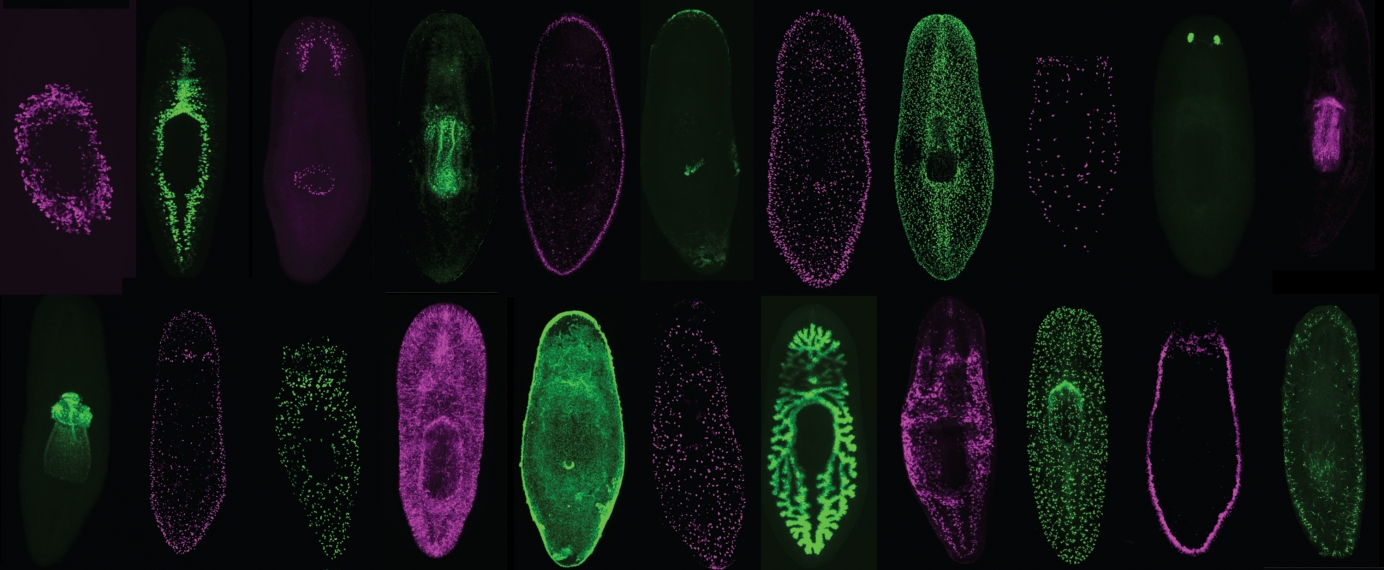Models for Research
Meet some of the common and not-so-common species used for research at Whitehead Institute.

Whitehead Member Peter Reddien has created a transcriptome atlas for the planarian flatworm.
Christopher Fincher/Whitehead Institute
Some flew and some swam to greatness. Others earned accolades by being cheap and easy to house. One lucky critter wiggled all the way to a Nobel Prize. How? By becoming scientific supermodels. From mice to microbes, researchers depend on a motley cast of characters to play the role of model system. These organisms share many genes with humans, are easily maintained in a laboratory setting, and have particular experimental advantages. Certain species, like the tiny water lily Nymphaea thermarum, are chosen as model organisms because of their place in evolutionary history or because their unusual traits make them ideal to study. By mimicking human diseases or recreating environments where scientists can study life’s basic biology, model organisms are used to investigate some of today’s hottest topics.
Planaria Dissection
Join Thomas Cooke, Postdoctoral Fellow in Peter Reddien’s lab at Whitehead Institute in a planaria dissection. He explains how, in some species, certain organs can restart their developmental programs after cells are lost or injured in order to regrow their missing parts. This type of regeneration research can help us understand how bodies develop and may contribute to the field of regenerative medicine.
Audience level: Middle and High School
What planarians are revealing about the rules of regeneration
In this video, learn how scientists in Whitehead Institute Member Peter Reddien's lab use planarians, a kind of flatworm that can regenerate, to probe the mysteries of how animals are able to replace missing body parts after injury — with the goal of one day using this knowledge to guide regenerative medicine techniques.
Toxoplasma gondii: a model apicomplexan
Sebastian Lourido explains why Toxoplasma gondii is an excellent system to study.
Sebastian Lourido uses the parasite Toxoplasma gondii as a model to study parasitic infection and disease.
Peter Reddien uses flatworms called Planarians as models to study regeneration.
Whitehead Institute researchers unravel the unique biology of apicomplexans — the parasites responsible for malaria, toxoplasmosis, and other diseases impacting global health.
Discover how graduate student Zak Swartz in Whitehead Institute Member Iain Cheeseman's lab uses colorful bat stars to study how cells divide.
Experience a multimedia story about fireflies, including how Whitehead Institute researchers rear them in the lab and what researchers hope to learn from investigating their biology.
Nymphaea thermarum (N. thermarum) is a tiny water lily that postdoctoral researcher Rebecca Povilus in Whitehead Member Mary Gehring’s lab is using to better understand the evolutionary history of flowering plants.
This edition of Unusual Labmates, our series on the species used for research at Whitehead Institute, focuses on fruit flies. Fruit flies may seem like pests when they are encountered in the wild. However, they have been used in research for more than a century, and in that time, they have been engineered to become powerful, malleable models capable of answering questions in many areas of research.
In this edition of our series Unusual Labmates, meet science's most beloved worm.
Axolotls (Ambystoma mexicanum) are a critically endangered species of salamander. They are also highly regenerative. Read the latest story in our Unusual Labmates series to learn more about these fascinating creatures, what Whitehead Institute researchers are hoping to discover by studying them, and why they are worth preserving in the wild.
Whitehead Institute Member Siniša Hrvatin is studying tardigrades to decode the mechanisms enabling their survival in extreme environmental conditions. Learn about the biology of these microscopic “water bears” and what makes them a particularly fascinating model organism.







